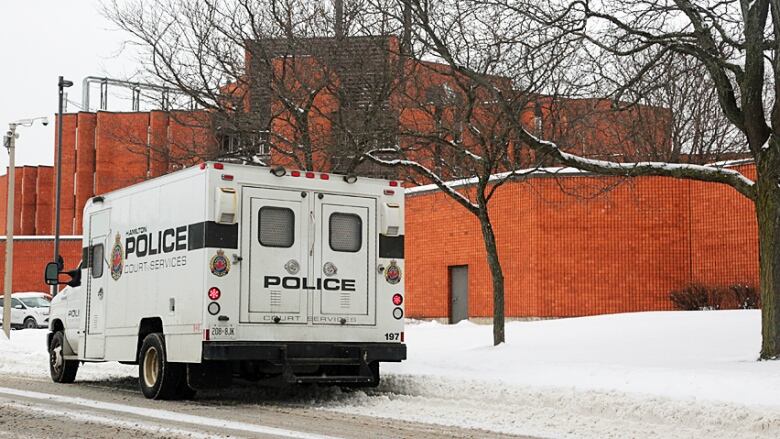'Extreme overcrowding' at Barton jail among human right concerns raised
Officials from the Ontario Human Rights Commission toured the jail and want to see conditions improved

The Ontario Human Rights Commission says that the Hamilton Wentworth Detention Centre is "extremely overcrowded" and needs to do more to deal with prisoners with addictions.
In a letter to the Ministry of the Solicitor General, the OHRC told the Ontario government that it couldstop a cycle of addiction and incarceration, and called on it to make a change to an approach "rooted in human rights."
The letter comes after commission leaders and stafftouredthe jail with a view to how it is meetinghuman rights standards. Its officials alsospokewith HWDC workers, prisoners and their families.
The letter detailing its findings says the conditions at the Barton Street jail fall "well short" of standards and guards feel they are not sufficiently trained.
Hamilton is experiencing the impact of the opioid crisis very directly in the correctional system.- Renu Mandhane, OHRC
In addition to overcrowding, it cited concerns about rare access to fresh air, and long wait times to see doctors and psychologists. The commission had praise for several initiatives at the jail but also suggested staff and correctional officers needed more support to address stress, reduce turnover and more effectively combat drug and overdose issues among inmates.
Urged to take tour
TheOHRChad been visiting correctional centres across Ontario since 2016 to monitor screening and treatment for prisoners with mental health disabilities. RenuMandhane, the OHRC's chief commissioner, added that she wascontacted by a family member of someone who had died at the detention centre, who urged her to tour the facility.
Aftera six-week long inquest into the deaths of eight men in 2018, a coroner jury produced 62 recommendations for the jail. The findings of OHRCparallel these recommendations andthe calls for action by prisoners and their families over the past few years.
At least 11people died from drug overdoses at the HWDCbetween 2010 and 2017, according to statistics from theOffice of the Chief Coroner. As of May this year, there had been 20 overdoses at the jail, with at least 3 of them fatal.
Poor living conditions
According toMandhane, HWDC is so overcrowded that cells originally designed for one person regularly hold three. And when the jail is locked down, prisoners can spend days confined in these rooms.
She said that this promotes stress and anxiety among prisoners and "can lead to 'voluntary' admission to segregation, use of intoxicants, violence or other harmful behaviours." This especially rings true for vulnerable prisoners, like young people and those with mental health disabilities.
She also noted that prisoners with mental health disabilities "continue to be placed in segregation."
The OHRC letter also revealedthat prisoners only have access to yard time every few weeks despite being required to have one hour of open air time daily. This also conflicts with HWDC's ability to accommodate prisoner's "creed-related needs." Though Indigenous prisoners are "offered the opportunity to smudge" this lack of outdoor time means they rarely get the chance.
While HWDCshares theseissues of overcrowding and the lack of fresh air with other Ontario facilities, Mandhane said that issues with creed accommodationweremore particular to Hamilton. She said she hadn't heard of issues withthe provision ofmeals and prayer spaces elsewhereat such a systemic level.
What might seem like small things...cumulatively amount to big things.- Renu Mandhane. OHRC
She explained that because prison food is "notoriously" low in quantity, people eat what they can and when they can. But eating outside of your faith can raise questions, despite the fact that "sometimes people act inconsistently with their beliefs because they're hungry."
It's the combination of these factors, Mandhane said, that helps contribute to tension.
"What might seem like small things...cumulatively amount to big things, " she said. "For a Muslim prisoner, that meal delivery and eating that halal food might be their only connection to their faith while they're inside."

Lack of training
As well as the shortcomings in living conditions, the OHRCexpressed concern fora lack of training among jail staff.
Correctional officers admitted that they are not adequately trained to operate the x-ray body scanner that detects contraband substances upon entry to the jail. All prisoners admitted into HWDC go through this x-ray.
The officers also questioned the approach of using drug-sniffing dogs. In one instance, there was an overdose one hour after the dogs went through the institution.
All those they spoke to admitted that "drugs are easily accessible" in the prison. They also expressed concern about overdoses, related deaths, and the demand for addiction-relatedtreatment and support.
"Hamilton is experiencing the impact of the opioid crisis very directly in the correctional system," Mandhane said. "But insome ways, that also means that it might be well poised to pilot innovative approaches to dealing with addiction."

Demand for drug-replacement therapy is high around 20% of all men and women prisoners request access. But insufficient staff resourcesmeans that nursing staff must relieved of other duties to help out.
HWDC adopts some of the best practices outlined by the OHRCfor protecting people with addictions from discrimination, like screening prisoners for possible drug-use or addiction-related issues when they enter the prison. But staff positions that assist with screening, treatment and support, such as psychiatrist and doctors, have a high turnover. The OHRC said that "many" of these positions were unfilled.
Revolving door feeds tensions
Mandhanesaid that the lack of support for workers could be a reason for this "revolving door" of both staff and prisoners with addictions. She explained that this creates a cyclical pattern, where the lack of staff contributes to the increase of lock downs, which in turn heightens tensions.
During her visit, officers expressed that they don't receive adequate training to cope with the stress of working on the front line.Those who have witnessed or been involved with overdose related emergencies or deaths are not relieved of their duties for "even a few hours", Mandhane said.Officers also are not proactively screened for PTSD.
The lack of staff training also creates barriers for prisoners once they leave. HWDC staff aren't trained to administer a screener that is a pre-condition for admission into community treatment programs. This means that prisoners cannot immediately enrol. Combined with delays in activating provincial health coverage after leaving HWDC, they're blocked from receiving treatment.

Ministry to conduct feedback sessions for officers
Mandhane added that she did see a few "positives" worth noting while touring the facility.Prisoners with mental disabilities are housed on units and ranges where the staff have specialized training from St. Joseph's Healthcare. And those with mobility-related needs also have full access to approved mobility devices. This doesn't happen at other facilities.
"I've heard that people have to rely on other people to carry them around," she said.
Andrew Morrison,media relations officer with the Ministry of the Solicitor General, told CBC News that the ministry "appreciates" the Ontario Human Rights Commissioner's comments. He said that the government is committed to reforming Ontario's correctional services and providing frontline officers with tools to keep them and those in custody safe.
Morrison added that the ministry will be conducting sessions with frontline correctional officers at institutions across Ontario, including HWDC, to get feedback on how to better support them.
Recent government action to support correctional services in Hamilton include the installation of a parcel x-ray scanner, implementation of weekly canine searches, and establishing an Institutional Security team. All new admissions in the Intake and Assessment unit will also be housed for one to three days before being placed with the rest of the prisoners to combat the introduction of contraband.












_(720p).jpg)


 OFFICIAL HD MUSIC VIDEO.jpg)
.jpg)



























































































